Dichotomous Keys Complete Guide
Edraw Content Team
Do You Want to Make Your Dichotomous Keys?
EdrawMax specializes in diagramming and visualizing. Learn from this Dichotomous Keys complete guide to know everything about the Dichotomous Keys. Just try it free now!
Classification and identification are very important in any scientific field – especially biology. Therefore, scientists have created a simple yet effective system to identify and group organisms in the right categories. This tool is known as a dichotomous key.
A Dichotomous Key categorizes the essential words and phrases. They are displayed in pairs, with each pair being labeled by an adjective describing the opposing word. For example, the first pair is "bigger," followed by "smaller." This method makes it easy to find these words. Use the Dichotomous Key when you need to categorize something into a few categories you will need to remember.
To create a dichotomous key, you must choose the objects that will be presented as key items in a table. These are the rows of the table. The rows should be similar, meaning that you can see a close relationship between the first and second row, and so on. The columns the properties of the key. In our example, the columns should be the same for all rows. For instance, if the property is the same for the rows, it may be that all rows will have the same weight or size, or color.
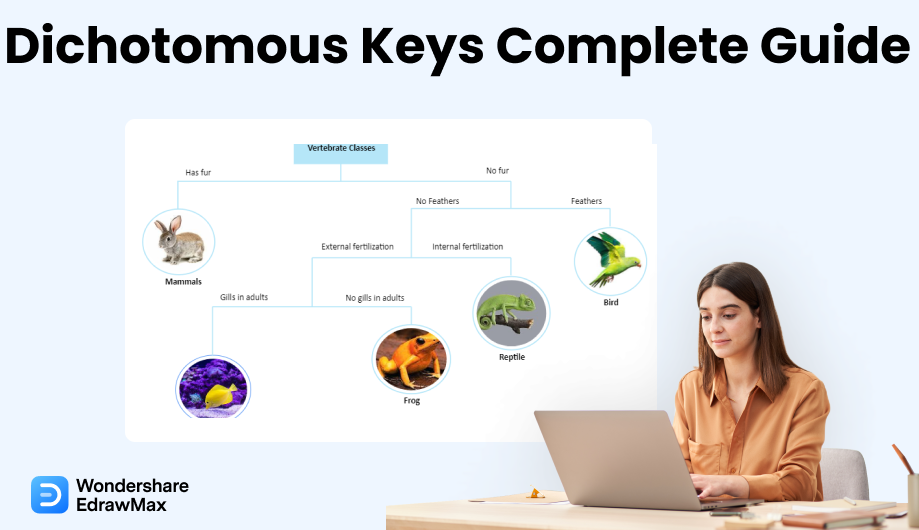
1. What is a Dichotomous Key?
A dichotomous key is a visual tool that allows users to determine and identify different creatures in the natural world like mammals, trees, reptiles, fish, rocks, and wildflowers. Dichotomous keys identify objects and organisms.
They are typically used for identifying plants and animal species on the basis of their characteristics. Moreover, they can also be used to identify minerals and any other object with observable traits.
A dichotomous key is a visual tool that allows users to determine and identify different creatures in the natural world like mammals, trees, reptiles, fish, rocks, and wildflowers. Dichotomous keys identify objects and organisms.
1.1 Uses of Dichotomous Keys
A dichotomous key is used in the field of biology and other sciences. As new species are discovered every day, it's important to have a technique to identify and classify them easily. So, the dichotomous key is the perfect tool for this.
Some common uses of the dichotomous key are:
- To identify and categories organisms.
- To help students easily understand complex scientific concepts.
- To simplify and organize large amounts of information for identification.
2. Types of Dichotomous Keys
"Dichotomous" means "divided into two." Hence, according to the dichotomous key definition, it always presents two choices in each step. The option you select in each step gives rise to new choices in the next step.
All dichotomous keys function in the same way, but there are several different ways of presenting them. Therefore, there are different types of dichotomous keys:
1. Nested Style
In a nested dichotomous key, the next question in a series is presented “nested” under the answer that leads to that question. Indentations are used to distinguish between the questions.
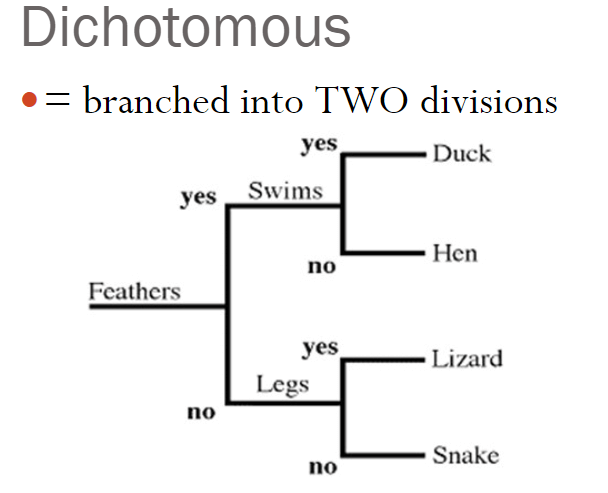
Image Source: slideplayer.com
2. Linked style
In the linked style of the dichotomous key, the questions are laid out in the form of a list. Each answer directs you to the next question, and the user has to find the correct item to identify the object or the organism correctly.
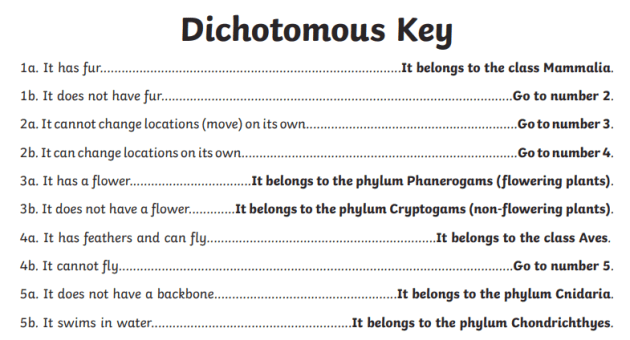
Image Source: www.twinkl.it
3. Branching Tree
In a branching tree layout of a dichotomous key, the characteristics of each organism are laid out like a flowchart.
Each characteristic or question gives birth to a new branch and carries a subsequent question as a sub-branch. The identification is revealed at the end of each branch.
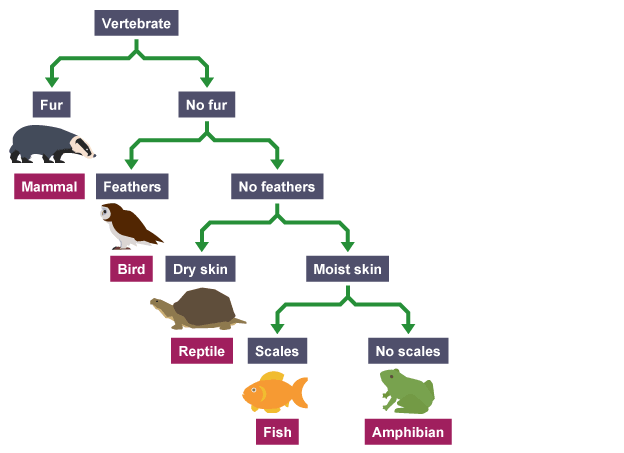
Image Source: evolvingsciences.com
4. Computer Program
Dichotomous keys are now being converted into computer program forms thanks to the global digitization. This allows users to answer questions one at a time to get the correct follow-up question automatically.
It is similar to an online quiz where the user reaches the correct identification after answering all the questions.
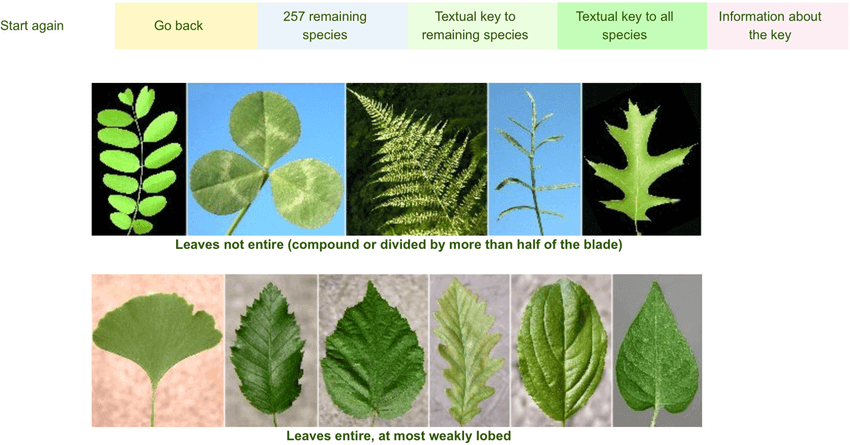
Image Source: researchgate.net
3. Dichotomous Key VS Taxonomic Key
In general, the dichotomous key is easier to classify, while the taxonomic key provides better data for analysis.
Dichotomous keys
-
Dichotomous keys are visual maps with pairs of categories, usually black and white, with no hierarchy.
-
A dichotomous key is a system for organizing a large group into two groups based on a single attribute.
-
The Dichotomous key helps you understand the subject matter of a page by assigning an A or B to each piece of information.
-
The binary choices don't necessarily make each dichotomy accurate. But the binary options do allow each dichotomy to be discussed in isolation.
-
For example, people can be either married or single, male or female, Democrat or Republican. The binary choices define each dichotomy
Taxonomic keys
-
Taxonomic keys are hierarchical charts that place each category in a series of classes above and below.
-
In a taxonomic key, attributes must be organized into fewer groups with more specific attributes.
-
Taxonomic keys help you organize your content into a hierarchical structure.
-
In contrast, a taxonomic system creates several categories based on different traits.
-
A taxonomy is a method for grouping related concepts into groups or categories. A taxonomy can be created by different grouping types of items, such as animals, by similar traits, such as color.
4. Dichotomous Keys Examples & Templates
There are lots of templates and dichotomous keys examples to choose from. They are usually offered with the software package, so you have to download them before using them. Dichotomous keys are like labels that you put on various subjects. By using dichotomous keys, you can organize learning content, making it easy to find specific content and learn the subject. Learning content can also be arranged by topics.
Edrawmax offers templates that you can use to create unique Dichotomous keys. Dichotomous key templates can be used for various purposes. The templates are arranged into groups and are categorized according to their type. You can select a template for each category.
Example 1: Dichotomous Key for Animals
Animals are checked on whether they are vertebrates, then classified into two groups: Mammals and Birds. Furthermore there is a decision row if they have wings or not. Dichotomous key can be used to classify animals according to whether they are solitary or gregarious, territorial or non-territorial, and diurnal or nocturnal. It makes it easier to compare the differences and the similarities, so that they can be more easily distinguished.
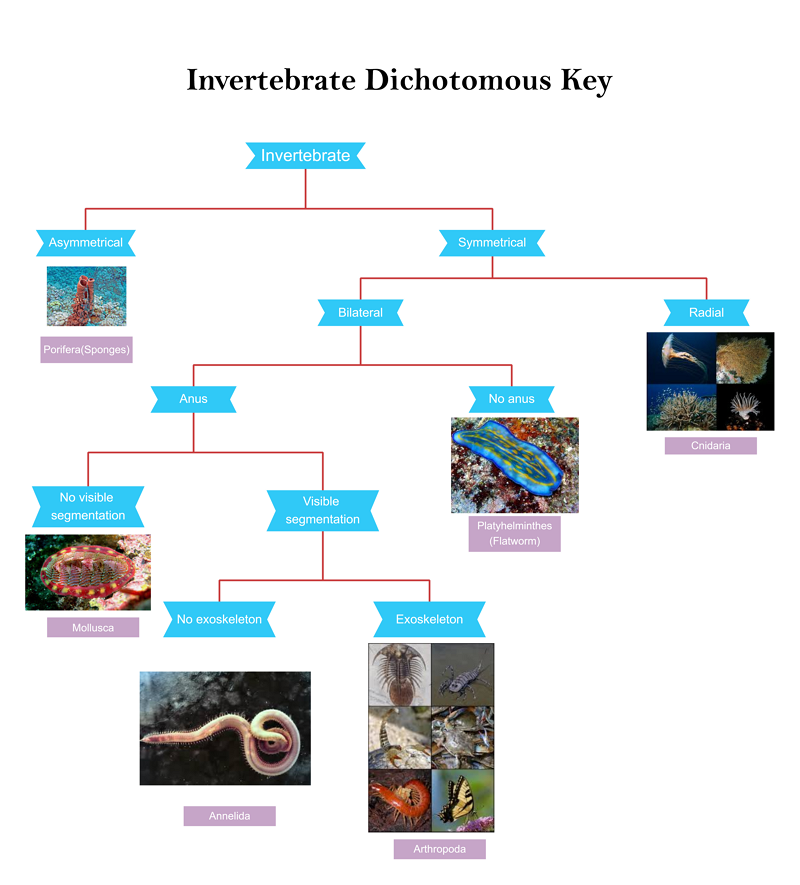
Example 2: Dichotomous Key for Insects
There are more than 20,000 insect species. A new research project has found that this huge number of insects are so important that they can have an effect on human health. All insects belong to one of two groups, depending on whether their bodies are covered with a hard cuticle or a soft integument. Those insects with hard exteriors are called crustaceans; those that have soft, flexible exteriors are called insects. Insects are usually referred to by their specific class. For example, wasps are Hymenoptera, bees are Apidae, flies are Diptera, butterflies are Lepidoptera, and beetles are Coleoptera. On all these bases they are easily classified by referring to the dichotomous keys.
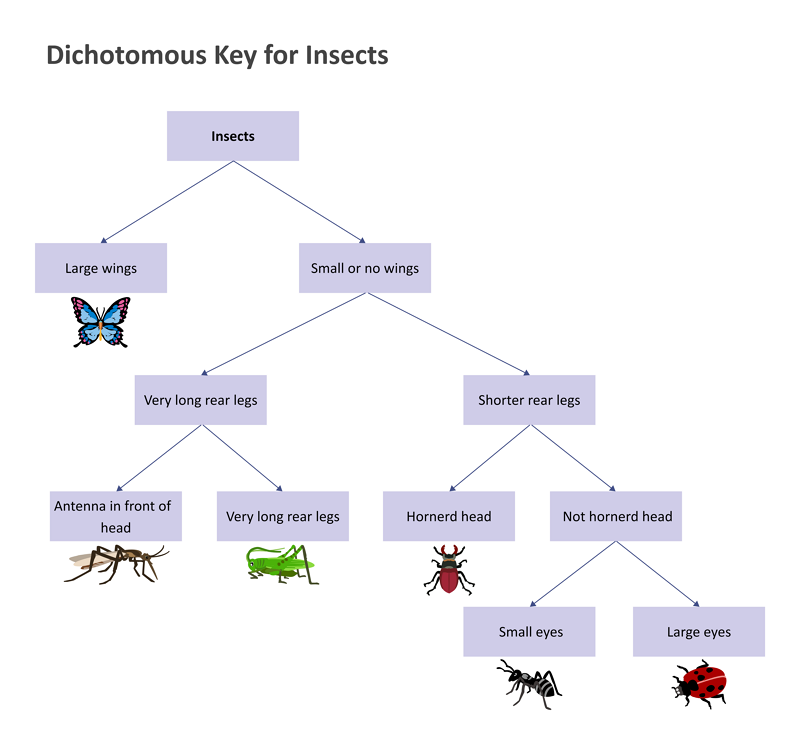
Example 3: Dichotomous Key for Plants
Dichotomous keys for plants will help increase plant knowledge and awareness of what is new and what we are growing. Plants are either in the ground or they are not. Dichotomous key is a method to classify plants into major groups of life forms. For example, dichotomous key helps us to divide plants into two main groups: gymnosperms (coniferous) and angiosperms (flowering plants). To see the dichotomy in plant growth, think about the difference between seeds and seedlings. These keys are used to foster a network of plant growers and help them grow, by sharing their experiences in growing plants.
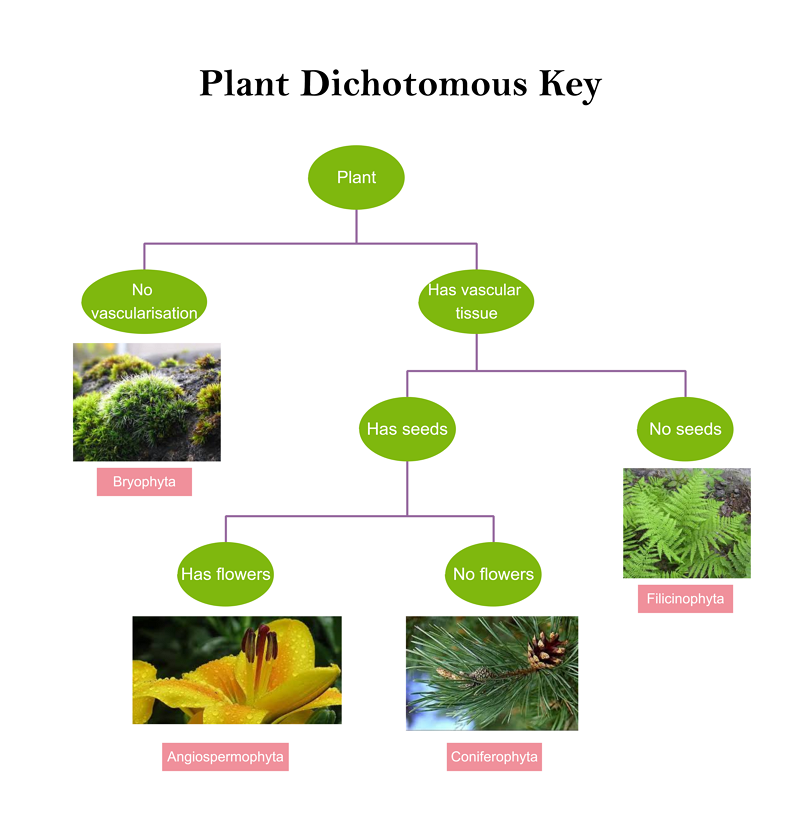
5. How to Make a Dichotomous Key?
To create a dichotomous key, both qualitative and quantitative factors are considered. It can be done in visual form (flowchart) or a written format (quiz).
Step1 Open EdrawMax and Login
The very first step that you need to follow is to install EdrawMax in your system. Go to EdrawMax Download and download the Dichotomous Key software depending upon your operating system. If you need remote collaboration with your office team, head to EdrawMax Online and log in using your registered email address.
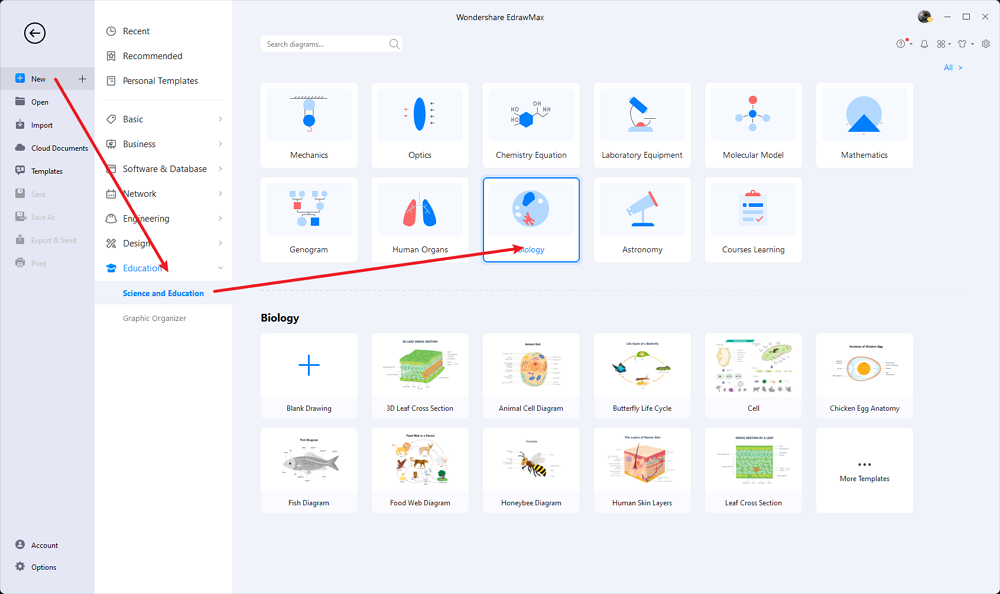
Step2 Select a Template
After launching, the Home screen opens by default. Head to the Template bar and search for Biology Diagrams in the search box. In-built templates specific to your search will appear on the screen. EdrawMax features a large library of templates. We have more than 25 million registered users who have produced thorough Templates Community for each design. Select the template you like and click Use Immediately to open it in a new window for customization.

Step3 Create From Scratch
From the EdrawMax homepage, you will find the '+' sign that takes you right to the canvas board, from where you can start designing the Dichotomous Key from scratch. Coupled with your technical expertise, you can use a wide range of symbols to draw a detailed Dichotomous Key.

Step4 Select Symbols
EdrawMax includes a large number of symbol libraries. You may quickly build any type of diagram with over 26,000 vector-enabled symbols. If you can't locate the symbols you need, you can easily import some images/icons or build your own shape and save it as a symbol for later use. Simply go to the 'Symbols' part of EdrawMax and select the 'Predefined Symbol' section from the top toolbar. Hundreds of symbol categories are accessible for you to utilize and incorporate into your Dichotomous Key.

Step5 Add Components
After you have sketched out the basic pieces, you may customize the typefaces, colors, and other details by selecting the right or top menu to make your key design more visually appealing. Also, feel free to draw ideas from other layouts on Templates Community and transfer some of the photos or features that you think would go well with your key design.

Step6 Wrap it up
Once the dichotomous key is complete, you may engage with your workgroup to get their feedback by using our Cloud-based files; EdrawMax supports exporting data into a variety of categories, including Graphics, Microsoft Office, HTML, PDF, Visio, and others. You can also share via social networks or emails. You can also print it or display it to others by utilizing "Presentation Mode."

Basically, it is simple to create a Dichotomous Key in EdrawMax, just grab a template and keep customizing, drag and drop professinal Dichotomous Key symbols to make your plan better. If you are still confusing about how to make a Dichotomous Key in EdrawMax, you can find more tutorial videos from our Youtube.
6. Free Dichotomous Keys Software
Drawing a Dichotomous Keys on paper by hand is too complex and exhausting. And so are other online tools, which can also be difficult to use. You might miss some vital details or have too many errors when drawing on paper. That is why it is recommended to use EdrawMax, a professional and free Dichotomous Keys software that is user-friendly and easy to use.
EdrawMax is an all-inclusive diagramming tool that you can use to create not only a Dichotomous Keys but other graphical illustrations as well. With well-equipped rack symbols, fonts, and so much more, making server rack representations could be as simple as possible. Moreover, with EdrawMax, users can customize their diagrams and save their work in multiple formats.
The best EdrawMax features that can assist you in your Dichotomous Key:
- EdrawMax Dichotomous Key software is compatible with multiple devices including Windows, Linux, and Mac devices. So, you can access diagrams online anywhere and at any time.
- Over 280 types of diagrams including flowcharts, tree diagrams, mind maps, architectural diagrams, wiring plans, and more.
- Export your work across a wide range of format options such as HTML, document formats like PowerPoint, Word, and PDF, image formats like PNG and JPEG and so much more.
- EdrawMax has a huge library of customizable templates to meet everyone's needs. Professionals always update these templates with creative ideas.
- Advanced user-friendly UI. You will feel right at home even with no experience in design. A complete set of symbols and general art tools to help you to tailor your drawings according to your liking.
- Easy to draw an idea or an illustration. You can use any of the many options available to edit and modify your work endlessly.
7. Final Thoughts
Edrawmax offers templates that you can use to create unique Dichotomous keys quickly. Dichotomous essential templates can be used for various purposes. The templates are arranged into groups and are categorized according to their type. You can select a template for each category. In education and teaching, dichotomous essential templates can organize learning content into different categories. This helps to categorize learning content, and the learner can more easily search and locate needed information. In business, they are commonly used for creating key accounts. And in marketing, it can be used to develop various key accounts, including the top 10, the top 20, the top 30, the top 50, and so on.
The moment you start using EdrawMax , you will realize that the tool comes with several amazing features that ease your efforts in creating the Dichotomous Keys and help you share the designs using the easy sharing option. With EdrawMax, you can export your file into multiple formats, and share your works on different social media platforms, like Facebook, Twitter, LinkedIn, and Pinterest. All in all, EdrawMax is a wonderful tool that caters to all of your designing and drawing needs.

Network Diagram Complete Guide
Check this complete guide to know everything about the network diagram, like network diagram types, network diagram symbols, and how to make a network diagram.
You May Also Like
Rack Diagram Complete Guide
Knowledge
Campus Area Network Complete Guide
Knowledge
Network Topology Complete Guide
Knowledge
Logical Network Diagram Complete Guide
Knowledge
MAN Diagram Complete Guide
Knowledge

